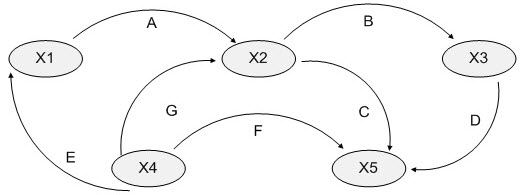Newly Updated Set of 1145 Absolutely Unique Questions
Largest Databank of Sample Questions to prepare for ISTQB (CTFL) Foundation Level Certification Exam
The Questions Databank is divided into Three Parts:
Part -1: Set of 1060 Nos. Questions from ISTQB CTFL exams in the past
Part -2: Set of 60 Nos. Special Questions (K-Level Wise) carrying detailed explanation in favor of the Correct Answer
Download Link for the First set of 10 Questions
Part -3: Set of 25 Nos. Quick Concept Review Questions (True / False) Type
Download Link for the set of 25 Questions
#############################################################
Part -1: Set of 1060 Nos. Questions from ISTQB CTFL exams in the past
Objective Type / Multiple Choice Questions – Begin with First Set of 10 Questions
Q. 1: How many test cases are required to cover 100% 0 – switch coverage respectively from X2?
Exhibit:

A. 4
B. 1
C. 3
D. 2
<<<<<< =================== >>>>>>
Q. 2: From a Testing perspective, what are the MAIN purposes of Configuration Management?:
i) Identifying the version of software under test.
ii) Controlling the version of testware items.
iii) Developing new testware items.
iv) Tracking changes to testw are items.
v) Analysing the need for new testware items.
A. ii, iv and v.
B. ii, iii and iv,
C. i, ii and iv.
D. i, iii and v.
<<<<<< =================== >>>>>>
Q. 3: Which of the following is a MAJOR task of test planning?
A. Scheduling test analysis and design tasks.
B. Initiating corrective actions.
C. Monitoring progress and test coverage.
D. Measuring and analyzing results.
<<<<<< =================== >>>>>>
Q. 4: Based on the IEEE Standard for Software Test Documentation (IEEE Std 829 – 1998), which of the following sections are part of the test summary report?
a) Summary
b) Test incident report identifier
c) Test deliverables
d) Risks and contingencies
e) Variances
f) Approvals
g) Output specifications
A. a, e and f
B. a, c and d
C. a, b and f
D. a, d and e
<<<<<< =================== >>>>>>
Q. 5: Which is a potential product risk factor?
A. Failure of third party vendor
B. Training issues
C. Problems requirements definition
D. Poor software functionality
<<<<<< =================== >>>>>>
Q. 6: Who typically use static analysis tools?
A. Customers and users
B. Developers and designers
C. Business and systems analysts
D. System and acceptance testers
<<<<<< =================== >>>>>>
Q. 7: Who would USUALLY perform debugging activities?
A. Developers.
B. Analysts.
C. Testers.
D. Incident Managers.
<<<<<< =================== >>>>>>
Q. 8: Which of the following would you NOT usually find on a software incident report?
A. The name and / or organisational position of the person raising the problem.
B. Version of the Software Under Test.
C. Suggestions as to how to fix the problem.
D. Actual and expected results.
<<<<<< =================== >>>>>>
Q. 9: Which of the following defines the expected results of a test?
A. Test case specification.
B. Test design specification.
C. Test procedure specification.
D. Test results.
<<<<<< =================== >>>>>>
Q. 10: Some tools are geared more for developer use. For the 5 tools listed, which statement BEST details those for developers
i) Performance testing tools.
ii) Coverage measurement tools.
iii) Test comparators.
iv) Dynamic analysis tools.
v) Incident management tools.
A. i, iii. and iv. are more for developers.
B. ii. and iv. are more for developers.
C. ii, iii and iv. are more for developers.
D. ii. and iii. are more for developers.
Correct Answer of the above Questions
Access the Full Database of all Questions

An expert on R&D, Online Training and Publishing. He is M.Tech. (Honours) and is a part of the STG team since inception.
